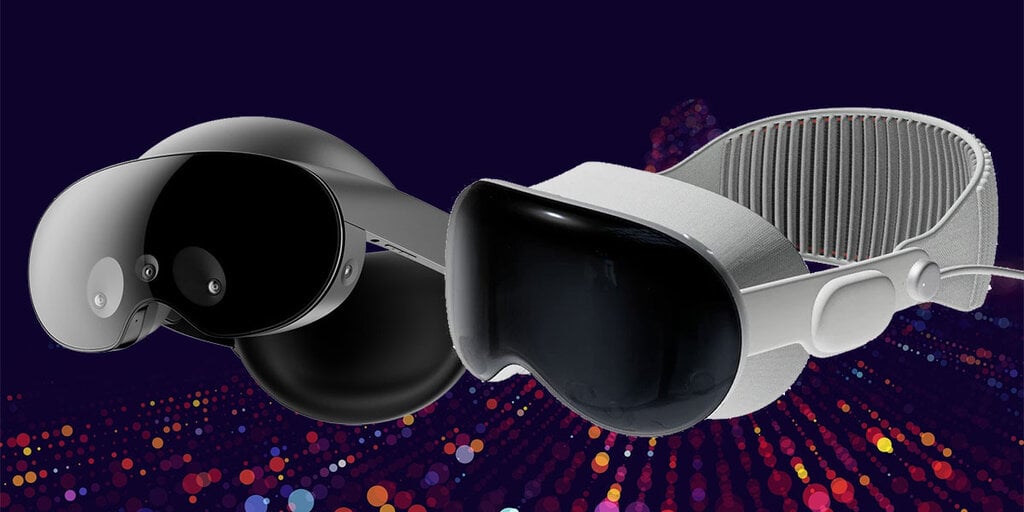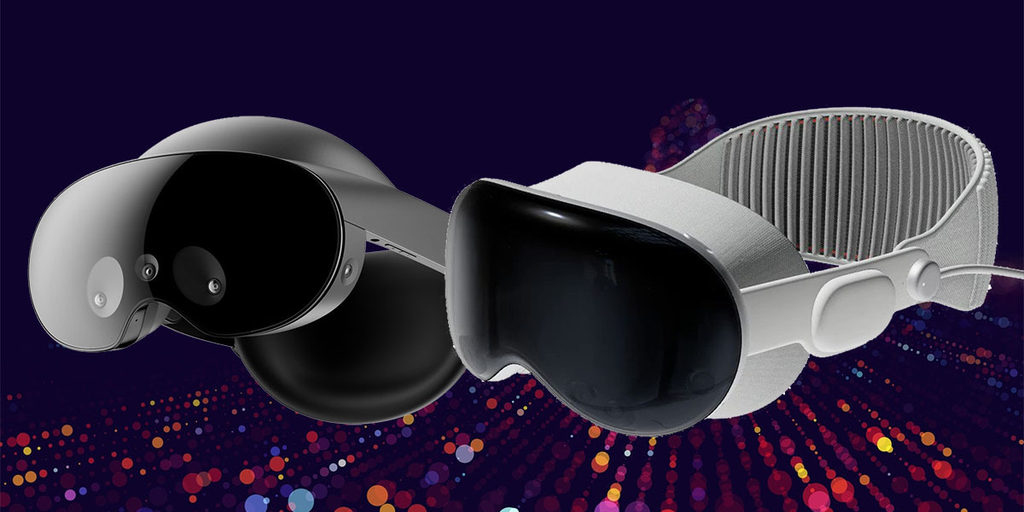[ad_1]
This story comes from GG. Your Web3 Gaming Power-Up
Discover GG
The headset wars are heating up: Apple finally revealed its Vision Pro device this week, with the mixed reality headset providing both augmented reality (AR) and virtual reality (VR) capabilities. It’s a high-end, cutting-edge device with a lavish price point to match.
And when it lands in early 2024, it’ll face competition from another “Pro” headset that’s already on the market from a rival tech giant: Meta’s Quest Pro, a more advanced riff on its popular (and much more affordable) Quest 2 device.
The two Pro devices share some common features and capabilities, but they’re also far apart in some ways, especially regarding price, power, and high-end features. Here’s a look at how the Apple Vision Pro and Meta Quest Pro compare—and if you missed it, be sure to read our head-to-head look at the Vision Pro and upcoming Meta Quest 3.
Price and availability
Apple’s Vision Pro will roll out early next year in the United States at a startling price of $3,499. For example, that’s dramatically more expensive than a MacBook featuring the same processor and far more costly than the current crop of consumer-focused AR and VR headsets.
The Meta Quest Pro appeared pricey compared to previous Quest headsets when it debuted at $1,500 last fall—but following a muted response and mixed reviews, Meta dropped the price point to $1,000. That’s more than three times the price of the entry-level Quest 2, but still a fraction of Apple’s ask.
Design and hardware
The difference here is much the same as you’d find in comparing a high-end “flagship” smartphone with a budget model. The Apple Vision Pro is heavy on sleek metal and glass, all curvy and slim.
Meanwhile, the Meta Quest Pro is a bit larger, boxier, and dominated by black plastic. We don’t have exact dimensions or weight yet for the Vision Pro, but the Quest Pro weighs in at 722g—about 44% heavier than the base level Quest 2 model.
The Quest Pro comes with a pair of physical motion controllers and a charging dock for the headset and controllers alike. Meanwhile, the Apple Vision Pro does not rely on controllers, instead reading finger and hand movements via the cameras and sensors. It will support Bluetooth gamepads for video games, though.
Display
Apple has gone seriously high-end with the screens in the Vision Pro, with a pair of displays that it claims to provide a better-than-4K resolution image for each eye, packing in over 23 million pixels between them. Early hands-on reports suggest that the view is very clear and better than other headsets on the market.
And there’s another display—one on the outside of the headset that shows a view of the wearer’s eyes via an internal camera. That’s intended to enable more natural interactions with people around you, so you don’t feel like you need to pull off the headset to hold a conversation.
Meanwhile, the Meta Quest Pro delivers a resolution of 1,920 x 1,800 per eye, which yields about 7 million total pixels. In other words, it’s a significant difference—a denser screen typically means crisper text and sharper graphics—and the Quest Pro has no external display to share a look at the wearer from inside the headset.
Power and battery
As with our previous match-up between the Apple Vision Pro and the Meta Quest Pro, this compares a powerful computer and a powerful smartphone. The Vision Pro packs the same M2 processor used in Apple’s latest class-leading laptops and a separate chip designed specifically to interpret camera and sensor data.
Meanwhile, the Quest Pro uses Qualcomm’s Snapdragon XR2+ chip—a processor built for headsets but ultimately based on its widely-used smartphone tech. The Quest Pro pushes out solidly impressive 3D experiences, but the Vision Pro is likely capable of much more immersive apps and games.
In terms of battery life, however, they’re in the same ballpark: Apple promises up to two hours of use with the Vision Pro, while Meta provides a 1-2 hour estimate for the Quest Pro. Meta’s headset has the battery built into the headset itself, while Apple opted for a battery pack that connects via a cord and can sit in your pocket or nearby. Both headsets can also be used indefinitely while plugged into a wall.
Content
Apple showed a wide array of potential use cases at the WWDC presentation. Thanks to floating windows, web browsers, and apps, you can use the Vision Pro for productivity needs. You can also watch movies and other content via floating screens, whether set against your real-world surroundings or in various fully digital virtual settings.
The Vision Pro can be used for video calls via FaceTime and other apps, with the other person seeing a digital recreation of the wearer that reacts in real time. The headset can snap and view 3D photos and videos and run immersive apps and games—although Apple only showed ported iOS games from its Apple Arcade subscription, which run in floating windows.
Based on the initial look at the device, the Apple Vision Pro benefits from Apple’s vast ecosystem of existing apps, games, and services. Meta doesn’t have quite the same array of apps and features that we’re used to using in other contexts, but it has built up a library of VR apps and games over the last few years.
In terms of gaming and entertainment, that potentially gives Meta a big leg up in the short term, especially since Apple mostly glossed over the Vision Pro’s gaming functionality. But broadly, when accessing content and apps from iPhones, iPads, and Macs, Apple likely has a much larger trove of stuff for early users to access and play around with.
Verdict
As the names suggest, the Apple Vision Pro and Meta Quest Pro are both targeted at professional users and early adopters. And the price points match that vibe. Meta’s higher-end alternative to the entry-level ($300) Quest 2 is arguably out of reach to the average consumer at $1,000, but Apple’s headset takes that premise to an extreme at $3,499.
Whether the Apple Vision Pro experience justifies that vast price difference remains to be seen, but some apparent advantages are already in the mix. From power and screen quality to cutting-edge perks and compatibility with existing iOS and Mac services, Apple’s headset appears to top Meta’s offering in some fundamental ways.
On the other hand, the Meta Quest Pro does some of the same core things as the Apple Vision Pro at a fraction of the price. We can’t make a call here until the Vision Pro launches, and we see the final product and available apps and features at launch.
But even if Apple’s device is dramatically better than Meta’s headset, will there be enough of an audience willing to shell out $3,499 to join the spatial computing revolution? That’s a big “TBD” for now.
Stay on top of crypto news, get daily updates in your inbox.
[ad_2]
Source link


